Ap World History Exam Period 1 Review Lasseter
You've taken the course, you've put in the hours of studying for unit of measurement exams and completing the work assigned by your teacher, and now it'southward May…crunch fourth dimension for the 2022 AP® World History review test!
Taking any AP® class can exist hard and stressful, but if y'all set and follow the guidelines and resource below, yous will be even more armed with the noesis and confidence to pass the exam.
This postal service includes information about the format of the exam, the topics covered, and study strategies for the AP® Earth History test. Links to boosted information and resources are likewise provided throughout.
What's the Format of the 2022 AP® World History: Mod Exam?
| Section | Questions | Fourth dimension | % of Test Score |
| 1A: Multiple Choice | 55 questions | 55 minutes | 40% |
| 1B: Short Answer | 3 questions (some educatee choice) | twoscore minutes | 20% |
| 2A; Document-Based Question | one question | 45 minutes + xv min reading menstruum | 25% |
| 2B: Long Essay | 1 question (some student choice) | forty minutes | 15% |
Students are given some choice over the short answer questions to answer (part 1B) also as the specific long essay question to reply (role 2B).
You likely already know that AP® Modernistic Globe History covers the historical fourth dimension menses from 1200 CE to the present, a span of over eight hundred years!
The course is divided into ix total units broken down every bit illustrated past the nautical chart beneath. All topics are covered rather evenly past percentage, though units 3-six compromise a slightly college percentage of the exam.
| Units | Chronological Period* | Exam Weighting |
| Unit 1 : The Global Tapestry | c. 1200 to c. 1450 | 8 – x% |
| Unit 2 : Networks of Exchange | c. 1200 to c. 1450 | 8 – 10% |
| Unit of measurement iii : Land-Based Empires | c. 1450 to c. 1750 | 12 – 15% |
| Unit iv : Transoceanic Interconnections | c. 1450 to c. 1750 | 12 – fifteen% |
| Unit of measurement 5 : Revolutions | c. 1750 to c. 1900 | 12 – 15% |
| Unit half-dozen Consequences of Industrialization | c. 1750 to c. 1900 | 12 – 15% |
| Unit vii : Global Conflict | c. 1900 to the present | 8 – 10% |
| Unit 8 : Common cold War and Decolonization | c. 1900 to the nowadays | 8 – ten% |
| Unit nine : Globalization | c. 1900 to the present | 8 – 10% |
Source: AP®Earth History: Modernistic CED, Effective Fall 2019
*Events, processes, and developments are not constrained by the given dates and may begin earlier, or continue subsequently, the approximate dates assigned to each unit.
Return to the Table of Contents
How Long is the AP® Earth History: Modernistic Exam?
The AP® World exam begins with 55 stimulus-based multiple-choice questions. "Stimulus-Based" refers to the exam format in which groups of 3 to four questions are related to a single chart, graph, picture, or main/secondary source excerpt. This format requires you to analyze the stimulus to answer the questions fastened to it. The multiple-choice questions are xl% of the test and students have 55 minutes to complete the section.
After the multiple-option section, there is a brusque reply section. Y'all must respond the commencement two questions simply you have a choice between the third and fourth questions to answer a full of 3 short-reply items. The curt answer portion of the examination is 20% of the exam, and you accept 40 minutes to write out responses for this section.
Following the short answer portion, the test will accept one hour to respond the Document Based Question or the DBQs. These are extended response questions that yous will write based on a set up of primary and secondary sources. The DBQ portion makes up 25% of the full exam score.
The exam ends with the long essay portion where yous will respond to a question and craft an essay response. Y'all will have 40 minutes to write this essay, and it makes up xv% of the test score. Here is the link to the student folio that breaks downwards the exam format even further if you are looking for more details.
Render to the Table of Contents
What Topics are Covered on AP® World History: Modern Exam?
Albert provides an immense number of resources to assistance you prepare for the AP® World History: Modern Exam. Click here to access our practice questions for both multiple choice and gratuitous response particular types. There are also total-length do tests so you tin practice in a style that closely mimics the actual examination.
If you are looking for visual resources, those are covered as well. The chart below links to various videos—both brief and detailed— that explain many of the topics covered in this exam. Most students larn best through multiple channels, so Albert provides both print and visual learning tools!
| Unit | Topics Covered | Resources |
Unit of measurement 1: The Global Tapestry (1200-1450)
|
|
|
Unit of measurement 2: Networks of Exchange (1200-1450)
|
|
|
Unit 3: Land Based Empires (1450-1750)
|
|
|
Unit 4: Transoceanic Interconnections (1450-1750)
|
|
|
Unit 5: Revolutions (1750-1900)
|
|
|
Unit of measurement 6: Consequences of Industrialization (1750-1900)
|
|
|
Unit 7: Global Conflict (1900-present)
|
|
|
Unit 8: Common cold State of war and Decolonization (1900-present)
|
|
|
Unit 9: Globalization (1900-present)
|
|
|
Units 1 and two brand up betwixt sixteen-20% of the exam, Unit 3 through Unit 6 are the biggest percentage of the exam with a coverage range of 48-60% , and Unit vii through Unit ix make upwardly 24-xxx% of the test.
You can use this breakdown to guide exam preparations. For instance, if y'all study for 100 minutes, yous should spend between 48 and threescore minutes on Units 3-6.
Knowing the breakdown of the topics can be useful in being prepared for all portions of the exam, but particularly those that require a written response. The Document Based Questions (DBQs) cover a wide twelvemonth range and can be about whatever unit of measurement from the form. This might seem intimidating, just the documents themselves can assistance to provide context for your writing if you go stuck.
For the long essay question, you will be given three questions and you lot will choose ONE to construct an argument-based response. You lot will be writing virtually either the menses from c. 1200–1750, from c. 1450–1900, or from c. 1750–2001.
Return to the Table of Contents
What Do AP® Earth History: Modern Exam Questions Look Like?
The multiple choice questions on the exam have a stimulus attached that you lot volition use to reply the 2-iv questions connected to it. The stimulus could exist a political cartoon, picture, map, or some other type of principal or secondary source. Here is a link to an example of a multiple choice question you may meet on the exam. This question is about Inca territorial expansion in the 1400s, and there is a map to use in answering the question.
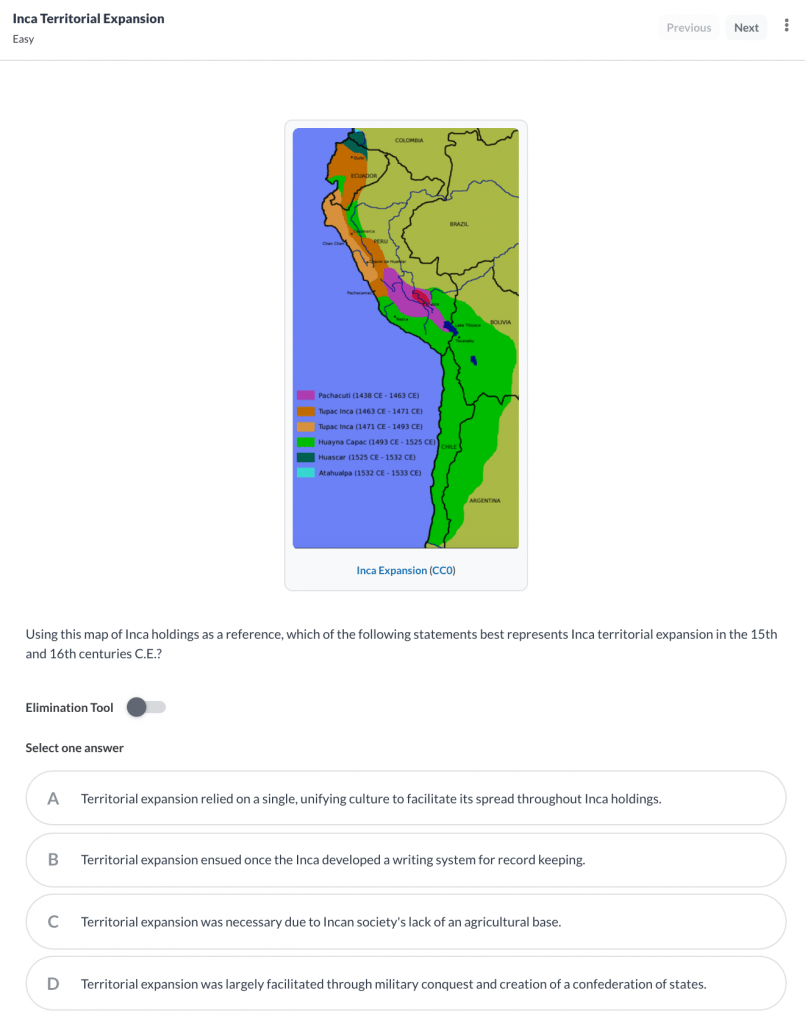
Older versions of the AP® exam did not always apply stimuli in the multiple-choice sections, merely the College Board decided that providing stimuli actually showcases a student's higher-society and critical thinking skills. These skills of analysis, evaluation, and synthesis are required to respond these questions (as well as your overall knowledge of the topic).
The stimuli not but helps to evidence how well y'all know the textile, simply having the stimuli can really assist you in answering questions if you have the time to clarify what is provided.
Other sections of the exam, every bit described above, are the short answer, long essay question, and document based question.
Albert, on the upgraded platform, provides many document-based and long-essay questions. Here is the link to a list of all the AP® Earth FRQs that Albert has to offer.
Below yous will find an example of one of the released free-response questions from the 2018 AP® World: Modern test.
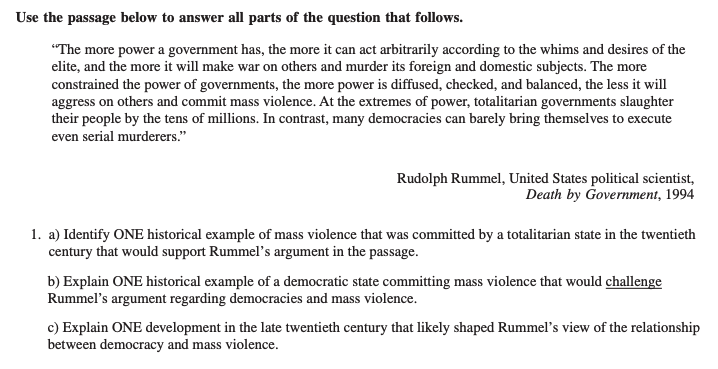
Source: College Board
Based on the scoring rubric that is provided by the College Board, at that place are recommended strategies to help y'all earn all 3 points for this gratuitous response question.
The first key to scoring well on this section of the exam is to truly make sure that you answer all 3 parts of the question. Brand connections and apply the stimulus to aid you construct your response.
Use the ACE acronym when amalgam your response:
- A: Reply the Question,
- C: Cite your supporting evidence, and
- E: explain how your evidence supports your response.
If yous notice in the answer breakup below, the answers don't necessarily connect to each other.Each role of a Short Answer Question is worth one point and scored independently from the others.
The response from part A does not have to connect to your answer for part B. For example, you tin discuss the Nazi Holocaust in role A, and and then you tin can discuss the actions of British soldiers in Commonwealth of australia. These historical topics do not accept connection to each other, but they answer function A and part B. To respond part C, you then make your merits about why the author may have fabricated his claim virtually the difference between totalitarian governments and democratic governments.
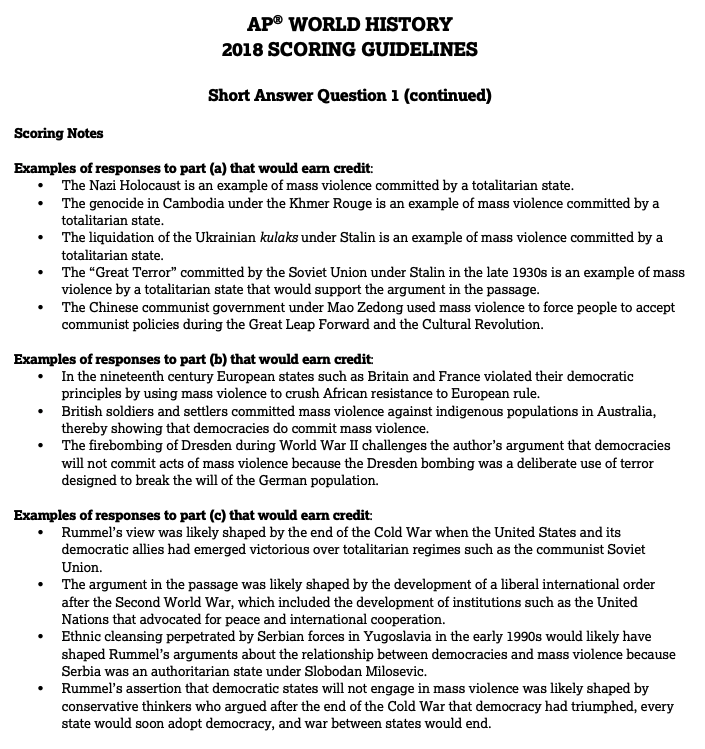
Source: AP® Cardinal 2018 Released Costless Response Questions
Focus on each individual part of the question and not necessarily the question as a unmarried overarching unit. This tin benefit you lot when writing a response because information technology guarantees that yous respond what each part of the question is request.
The multiple choice questions, as stated before, e'er have a stimuli attached. Below you will find an example of a question that you might come across on the AP® World History exam. On the AP® test, you would utilise this stimuli to answer iii-4 questions, but here is an example of one manner yous would utilise the map to respond a single question. This sample question is on the Albert website most the Industrial Revolution.
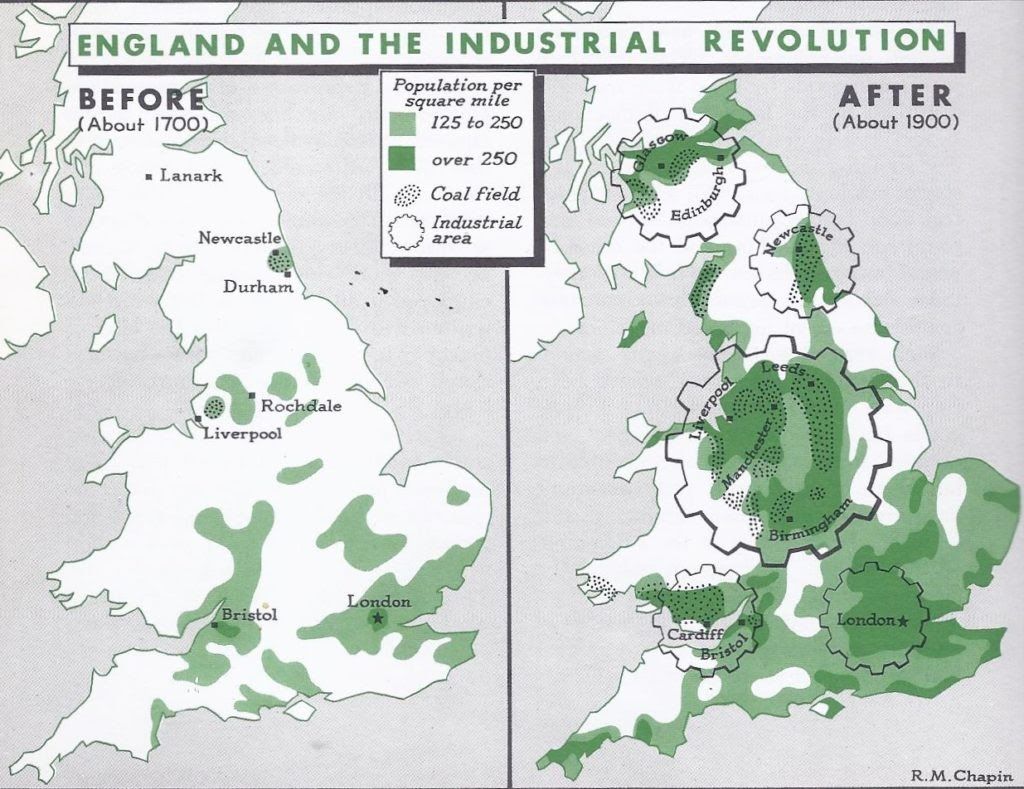
Question: What areas had the biggest population growth during the Industrial Revolution?
- Areas with considerable coal deposits
- Areas nearly the coastline
- Areas in northern England
- The areas of growth were not homogenous
One time you analyze the stimuli, which in this case is a map that shows the population difference due to the Industrial Revolution, the answer is (A).
The Industrial Revolution was driven by coal, and then the population grew nearly coal deposits since coal was needed to run factories during the Industrial Revolution.
Students accept one 60 minutes to answer the Certificate-Based Question, or the DBQ. These are extended response questions that you will write based on a set up of primary and secondary sources. The DBQ portion makes upward 25% of the total exam score. In that location are 7 possible points for the Document-Based Question (DBQ).
For a preview of what these prompts look like, hither's an example of a DBQ from a previous AP® World exam:
…and beneath are the accompanying documents from the 2019 DBQ. Notation: click on each certificate below to run into a larger view.
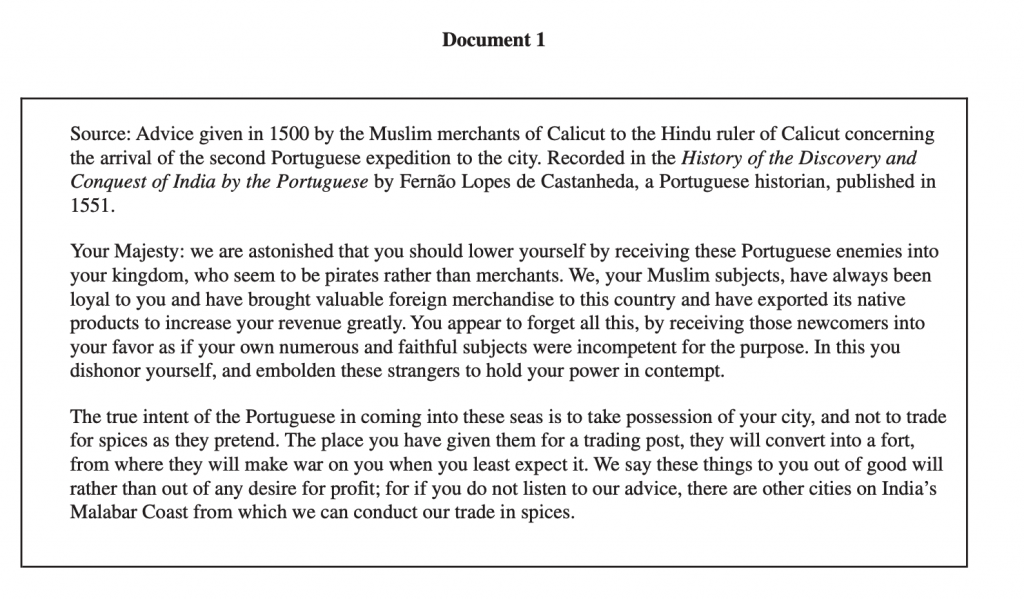
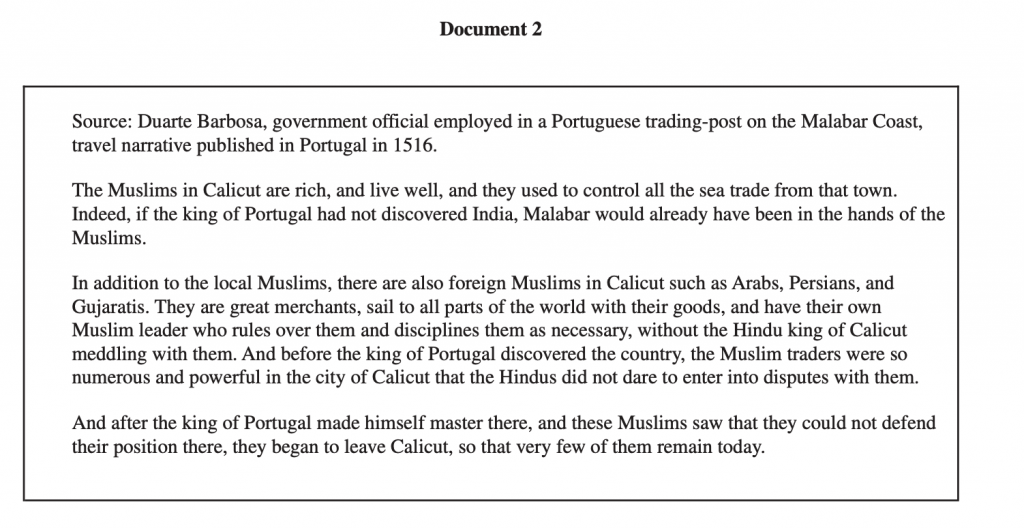
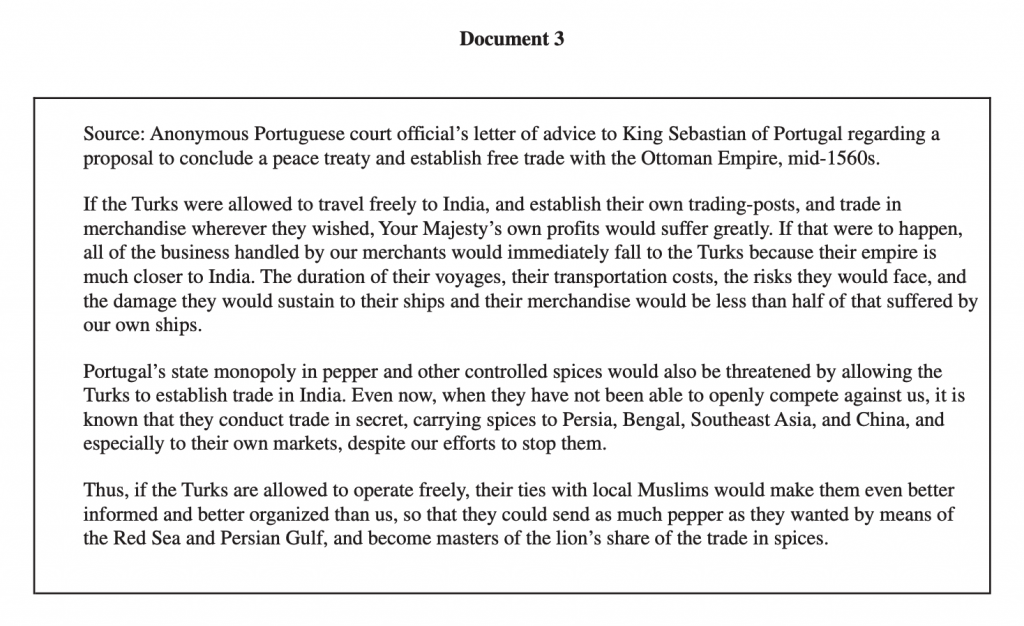
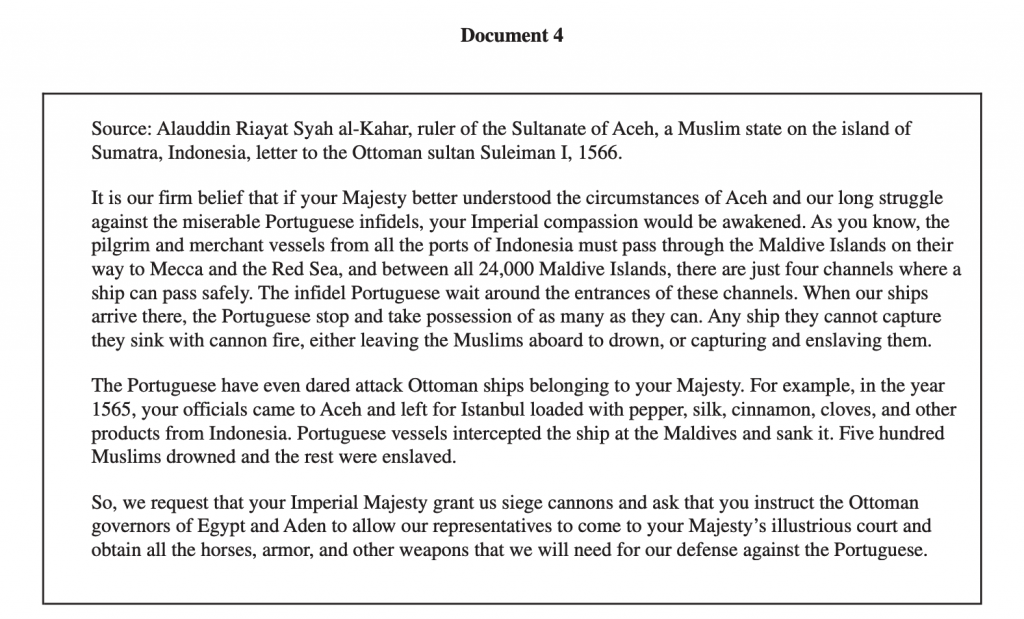
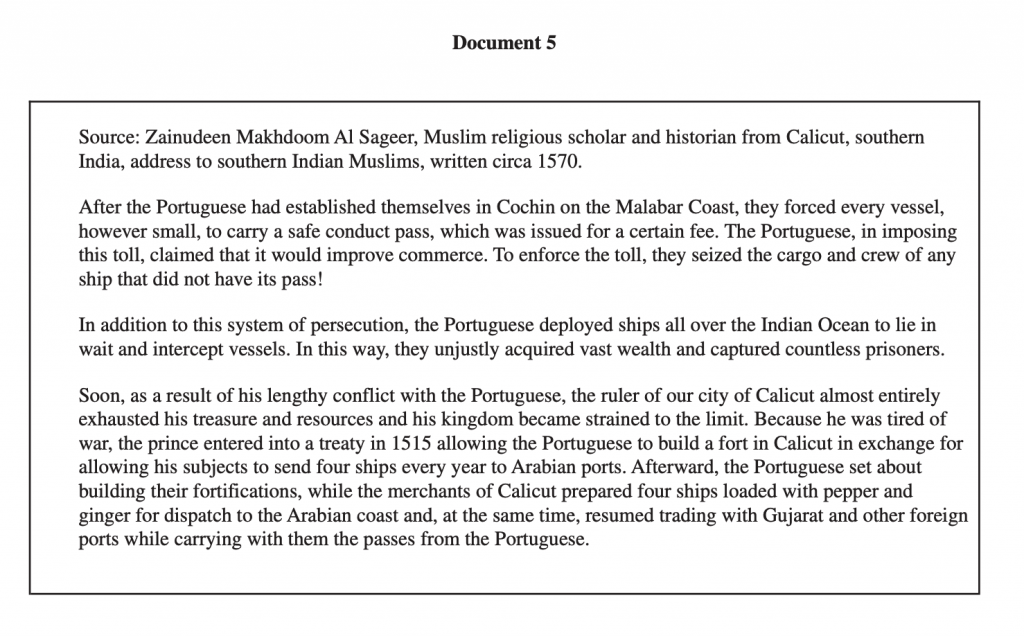
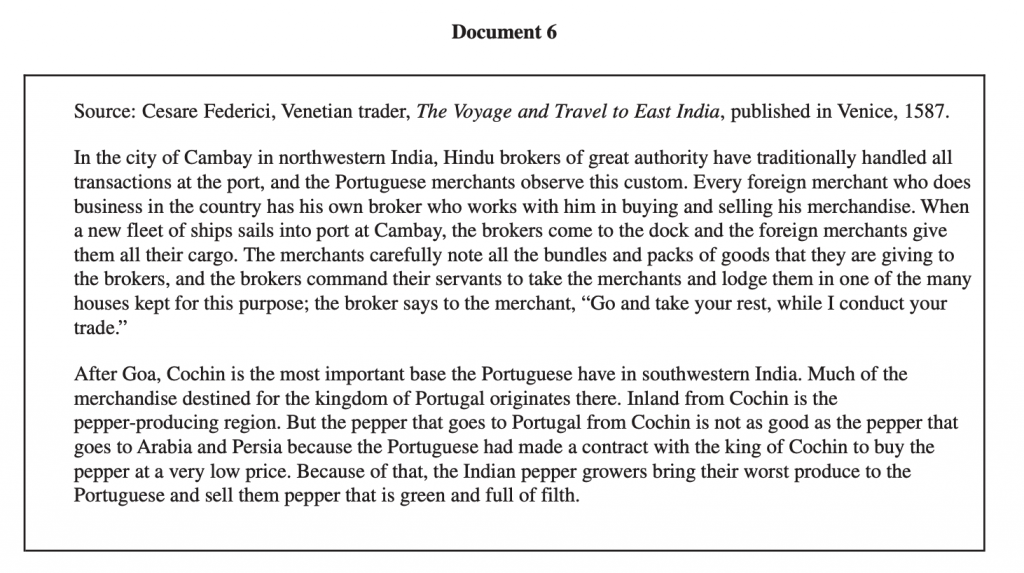
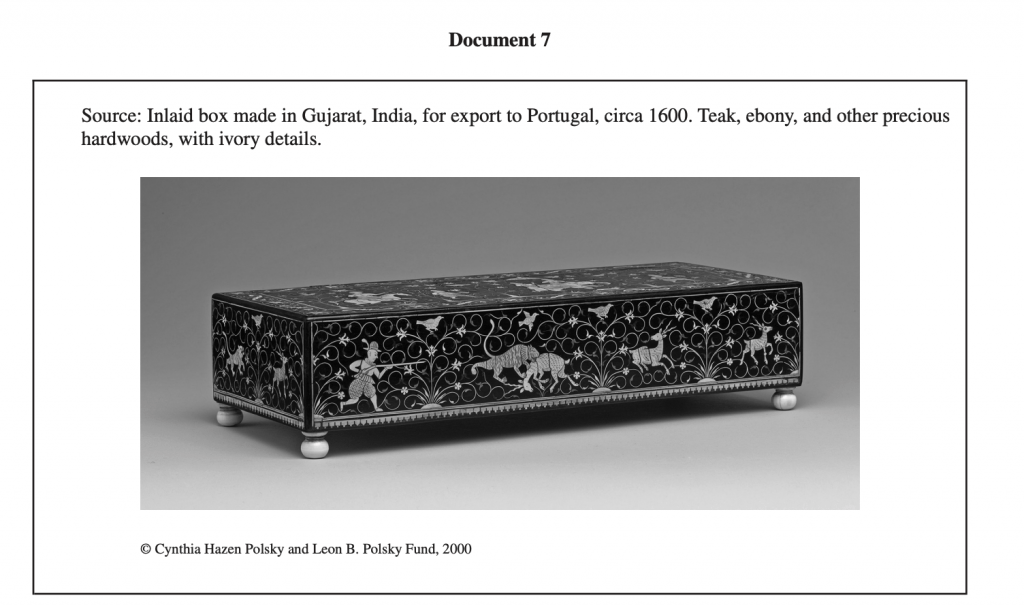
Additionally, the AP® World History: Modernistic examination includes a Long Essay Question (LEQ). Students are typically given 3 different LEQ prompts and are required to pick just one prompt to write their response.
Hither are the examples of three prompts from the 2019 test:
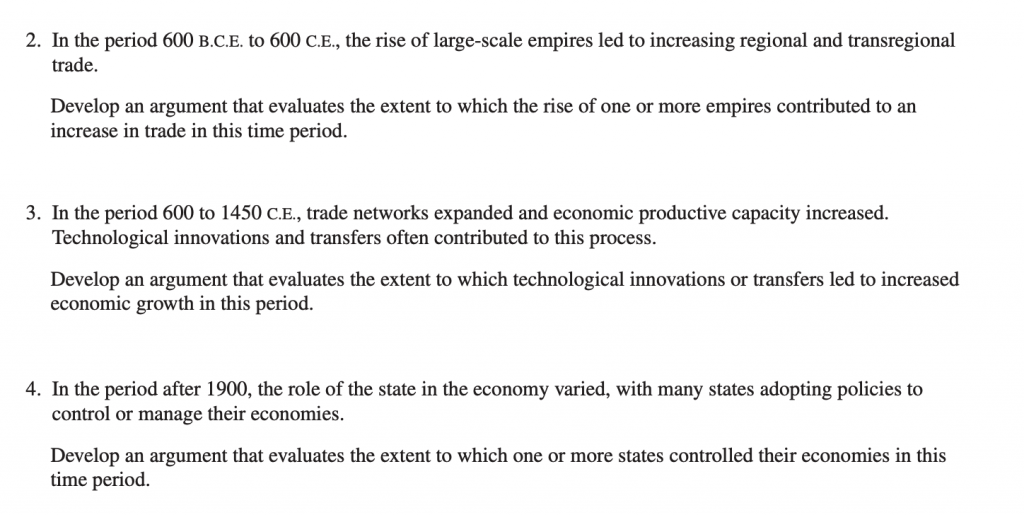
For more tips on how to answer these types of Free Response Questions on the AP® World exam, cheque out this article chosen "How to Answer AP® World History SAQs, DBQs, and LEQs".
Render to the Table of Contents
What Tin You Bring to the AP® World History: Modern Exam?
Hither is a list of items to bring on test day for in-person exams. To lessen the likelihood of stress on examination twenty-four hours, pack these items the nighttime before so yous are prepared.
DO bring these:
You should bring:
- No. ii pencils for your multiple-choice answer sheet
- Pens with black or dark bluish ink for completing areas on the test booklet covers and for free-response questions in most exams
- If you don't nourish the school where yous're taking the test, you volition too need a current regime-issued or school-issued photo ID. (Boosted ID may be required by authorized examination centers outside the United States.)
- Your College Board SSD Accommodations Letter if you are taking an exam with canonical testing accommodations.
Return to the Table of Contents
How to Written report for AP® Globe History: Modern Exam: 5 Steps to Success
Everyone has a different study method and way, but these five steps volition directly assist you in preparing for this exam.
1. Collect and organize all notes that you took during the yr.
Put your notes in chronological society and then highlight topics that you struggled with during the yr. Read through the notes, especially data from earlier in the twelvemonth.
2. Either talk over the data with another person or try to teach the topics to someone else once you lot have organized the information.
For example, you may accept a Socratic seminar with a study grouping from your form. You have likely participated in 1 during your course, but if you lot need help getting started here is a link to an outline for a Socratic seminar.
This tip can be very useful, simply it is recommended that you practice a Socratic seminar or grouping discussion method of your choice in chunks of no more than 1 hr. However, you should hold discussions at least 5 times.
iii. Exercise how yous would organize writing a DBQ, short answers, and long essay once yous take collected your information and discussed the information with your peers.
Your teacher has probably given you many extended response questions throughout the year that mimic the test, so utilise those to get started.
Use the organizational format that you similar best and take time to master rapidly mapping out an extended response.
Utilize your favorite writing outline spider web to practice sample questions that are provided on the AP® Central website or on the Albert website. If y'all don't have a favorite writing outline web, here is i that you might find useful .
Limit your prewriting to 15 minutes as y'all are preparing for writing essays on a timed test. However, you tin can practice planning out responses for multiple writing prompts during each study period.
4. If y'all are however struggling after you have done the first 3 steps, use the resources provided to you on the AP® Central website.
Use the resources, such as the released questions from the by three years of the exam on a daily ground when studying.
Practice and written report in small chunks throughout the weeks prior to the exam. Report for 20 minutes and then take a 10 infinitesimal break. One time yous take completed about one hour of studying, you should take an extended break.
5. To fill in gaps, watch videos on a variety of historical topics covered on the exam— like those linked to earlier in this post.
After watching the video, yous should write a ii-3 sentence summary about the video to refresh your memory about the topic.
Your summaries should not take long, so aim for 4 minutes maximum to jot down a quick summary of each video.
Return to the Table of Contents
AP® World History: Modernistic Exam: 13 Must Know Study Tips
1. You have taken a whole year or semester of this course, then accept a deep breath. You know this stuff.
Have time to do some deep breathing exercises that clear the listen and tin can assist with increasing focus. Here is a link to help you with deep breathing exercises.
ii. Practise multiple choice questions from previous tests that you took during the year.
Your teacher wrote questions for your unit of measurement tests to mimic the questions you will see on this exam. Create a fault log and cross-reference units to identify which units you lot demand to prioritize most. Look at your old tests and find which types of questions you struggled with the most to guide what to focus on while studying.
iii. Construct a free response question from 1 of the released questions from the Higher Lath or from Albert.
Here are all the practice questions released on the College Board 's website. Also here is the link to resources on the Albert website.
Write a free response long essay once a week for nigh one month prior to the test so you are able to write on a variety of topics and get comfortable with the allotted fourth dimension to do so.
four. If yous are a visual learner, watch the videos that are linked below for each unit of measurement.
Watching and hearing the information again may assist on test day! Once you take watched the videos, summarize the top iii takeaways from each video so you have a summary page to read over on exam twenty-four hours.
5. If y'all are an auditory learner, listen to historical podcasts on Spotify or listen to YouTube videos without watching.
Hither is a link to a few historical podcasts to gear up you for the exam. After you listen, summarize the top 3 takeaways from each podcast and then you take a summary page to read over on test day.
6. If you are a tactile learner, yous can rewrite or type your notes because the repetition volition assistance y'all remember the information.
This may audio pretty old school, merely repetition is beneficial to assistance people remember information.
vii. Time yourself on the multiple selection questions.
You lot will have ane minute per question considering in that location are 55 questions, and you have 55 minutes to complete the department. Larn to not dwell on questions and come back at the cease if yous demand to. Do non spend more than ane.5 minutes on a question, fifty-fifty if you are stuck.
8. Construct DBQ responses (certificate based questions).
Yous may detect these daunting since you lot take to use the source documents in your writing. Albert provides a diversity of DBQs that y'all can write during your study period prior to the test.
Merely like the free response questions, write no more than in one case a week but try to write a full of iv DBQs. But a reminder, you take lx minutes during the exam to construct a DBQ, and then time yourself during your writing.
Many students struggle with incorporating the documents into their writing. Attempt to use all the document s to support your argument.
Here is a link to a comprehensive post about the aspects of the FRQ's from Albert.
9. Practise your free response questions and learn nearly key turning points.
Y'all will not accept documents to help organize your response in this portion of the examination, so brand certain y'all have a general agreement of key themes through earth history.
If yous understand the units and can place historical events into these time periods, you take context for all your FRQ's.
10. Practice your short answers.
These can really assist your overall total score, and so make sure y'all take them seriously. Just besides make sure you don't ramble. Answer the question asked thoroughly, but practice not drag out the response. Here is an example short answer question and response from Albert.
xi. Try and report with a classmate.
Saying the information out loud and "education" others has shown to really assist students larn and recall information.
Apply the socratic seminar outline that is provided in the previous section for maximum touch on.
12. Trust that your teacher prepared you well! Apply your notes and resources that were given to y'all throughout the course.
Highlight topics that you struggled with during the yr and focus a larger portion (about 25%) of your studying efforts to learn that information.
13. Albert and AP® Central are great resources with many details if you have farther questions about the structure of the exam.
Accept one of Albert's full-length do tests, and then review which topics and units y'all struggled with most. From there, isolate your do to focus on these weaknesses so that you can make the about of your limited report time. After you've built up your confidence in these areas, have another total-length do exam; repeat this process until you experience gear up .
Return to the Table of Contents
AP® World History: Modern Exam: 5 Exam Day Tips to Remember
Here are some test twenty-four hour period written report tips to assist get you prepared to pass the AP® Earth History: Modern Exam:
1. Review information that y'all may take struggled with over the past couple weeks.
Do non spend more than fifteen minutes reviewing last minute information.
Read the summary sheets you lot nerveless from the videos and podcasts as well as your notes from your Socratic seminar.
two. Brand sure you bring the bag that you packed the night earlier with all the items you need to have the exam.
Review the bring and do not bring list from earlier in the mail service!
iii. On your mode to the exam, start talking to yourself. It may be a piddling funny, but saying things out loud is proven to help you call up the data.
According to psychologists , once you lot get your ears involved in the learning procedure, more senses are engaged with your learning.
4. Stay focused on what you lot are there to attain.
Go on your confidence level up but remain at-home. Use the deep breathing exercises that were provided in the 13 Must Know Written report Tips section.
Know that yous are prepared to pass the AP® Earth History: Modernistic Examination.
five. Take your time on your exam but proceed yourself organized, especially on the writing sections.
Remember that yous take 55 minutes for 55 multiple choice questions, so move speedily and exercise non dwell on questions for also long.
For the gratuitous response questions, you accept twoscore minutes to produce three short respond questions., Yous accept sixty minutes for the DBQ, and y'all have forty minutes for the long essay. Program on taking well-nigh five-eight minutes on planning before writing each free response question.
Return to the Table of Contents
AP® World History: Mod Examination Review Notes and Practice Test Resource
At present that you have read through this "How to Pass" guide, here are some great boosted resources to help become you lot more prepared for the AP® World History: Modern exam.
Two Additional AP® Earth History: Modern Resources:
Freemanpedia

This website provides resources for all topics and units for AP® World: Modern.
Use this site if: you need more in-depth resources nigh the entire course. This site provides a diversity of graphic organizers about key ideas for each unit.
Do non apply this site if: you lot do not like graphic organizers. There are a ton of them on each page for each unit.
Heimler's History: Youtube Channel:
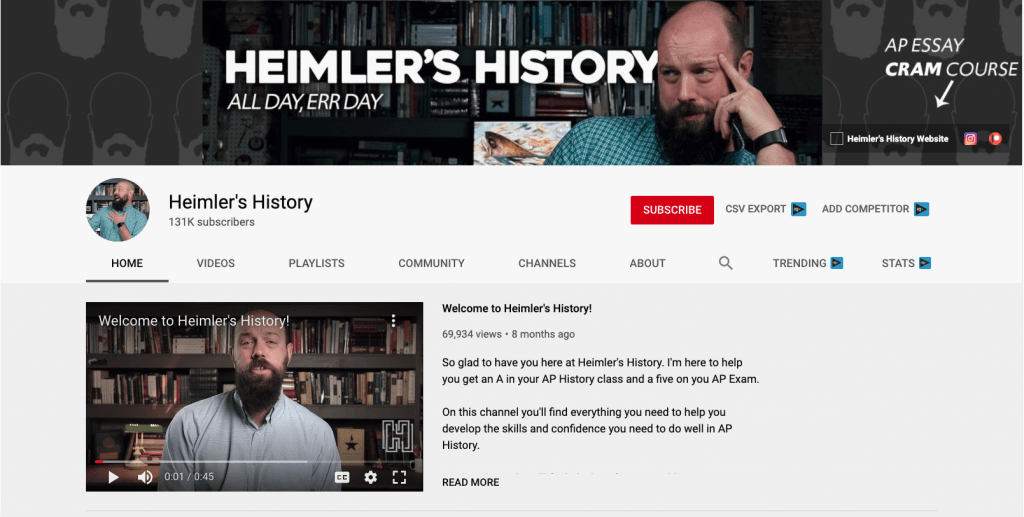
On this Youtube channel, y'all will find a collection of videos that cover the entire curriculum for AP® World History.
Use this site if: you are a visual learner and need a quick overview of each topic that you learned during the grade.
Do non use this site if: you are not a visual learner or you need more than in- depth data about a certain topic.
Return to the Table of Contents
Summary: The All-time 2022 AP® World History: Modernistic Examination Review Guide
Yous accept the information, you lot have the skills, and you lot have the motivation to go gear up to pass the AP® Modern Globe History exam. In this post there are a variety of resources to benefit a multitude of learners.
There are videos to help jog your retentivity nearly the topics covered in the examination. There are links to practice questions and more data if you take any farther questions nearly the AP® World History: Modernistic Examination.
This How to Pass AP® Earth History: Modern Review Guide will be a great starting and endpoint on your journey to get prepared. If you need any other resources, check the Albert website as there are many other resources bachelor! Good luck and stay positive…you got this!
Source: https://www.albert.io/blog/ap-world-history-review/
0 Response to "Ap World History Exam Period 1 Review Lasseter"
Post a Comment